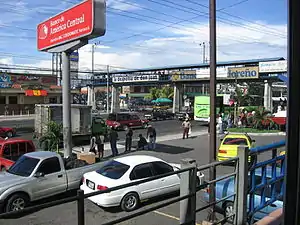Soyapango
Soyapango is a municipality in the San Salvador department of El Salvador. Soyapango is a commercial center. The municipality is the third most populated area in the country, with 290,412 inhabitants. Soyapango is a satellite city of San Salvador and it is the main thoroughfare between San Salvador and the eastern part of the country, and nearly 70,000 vehicles travel through it every day. The nickname for this satellite city is Soya. The city is infamously and notoriously known for being the most dangerous city of the Central America region, and also for being a breeding ground for the Mara gangs and the place where gang members first arrive after being deported to El Salvador from Los Angeles, reason why these two locations evoke a similar resemblance to each other.
Soyapango | |
|---|---|
Municipality | |
 | |
 Soyapango Location in El Salvador | |
| Coordinates: 13°44′N 89°09′W | |
| Country | |
| Department | San Salvador Department |
| Metro | San Salvador Metropolitan Area |
| Settled | 1543 |
| Incorporated (town) | 1907 |
| Incorporated (city) | 1969 |
| Government | |
| • Mayor | Jaime Lindo (Nationalist Republican Alliance[1] |
| Area | |
| • Total | 11.47 sq mi (29.72 km2) |
| Population | |
| • Total | 285,559[2] |
| 2007 Census | |
| Time zone | UTC−6 (Central Standard Time) |
| SV-SS | CP 1116 |
| Area code(s) | +503 |
| Website | soyapango.gob.sv/ |
Economy
Empresas ADOC, the largest shoe manufacturer in Central America, has its headquarters in Soyapango.[3]
Most economic activity in Soyapango is related to forestry.
Geography
It is limited by the following municipalities: the north by Delgado and Tonacatepeque; to the east by Ilopango, on the south by St. Thomas and San Marcos, and the west by San Salvador and Delgado. It is located between the geographic coordinates 13° 44'42 "LN (northern end) and 13° 39'58" LN (southern end), 89° 06'57 "LWG (eastern end) and 89° 10'16" LWG (far west) .
Soils
Soils predominate in the municipality of type: 1) and Regosols Andosols, which are areas that form rolling and rolling country areas, 2) Regosols, and Andosols Latosols reddish clay, which are land areas that form of hills and mountains of the belt volcanic foothills or lower slopes of the volcanoes or volcanic massifs. In this area dominated by rock types of pyroclastic material.
Hydrography
Water the town river Las Cañas, Acelhuate, Tapachula, Chantecuán, El Sauce, and Chagiiite Sumpa and Arenal streams, and other unnamed Aposento. The main rivers are the reeds and the Acelhuate. The river Las Cañas was born in the town of Ilopango, and enters Soyapango to 2.4 miles east of the city, describing a path from south to north. Its course and divided the territory and Tonacatepeque Ilopango. Its rivers tributaries Chantecuán, El Sauce, Zapotitán, bananas and Sumpa, and streams and Arenal The Pavas Seco. It has a length within the municipality of 5.5 kilometers. Acelhuate River rises in the municipality of San Salvador. Enter Soyapango to 2.3 miles west of the city, describing a course from south to north. Its course divides this territory and those of Delgado and San Salvador. Its tributaries to the river gorge Tapachula and El Arenal. Describes a trip within the municipality of 3.5 kilometers.
Terrain
This town has a topography ranging from rolling hills to rugged mountains, mostly prominently to the South. The landscape of the area has two geological features: Cerro El Mirador and Mount San Jacinto. Mount San Jacinto is the most prominent one. Located 3.1 miles southwest of the city of Soyapango, its summit serves as a marker for the municipal boundaries of San Marcos, San Salvador and Soyapango. It has an elevation of 1151.93 meters above sea level.
Climate
The amount of annual rainfall varies between 1.700 and 1.850 mm.
Sports
The local professional football club is named C.D. Marte Soyapango and it currently plays in the Salvadoran Second Division.
References
- "Nuevo alcalde electo de Soyapango celebra resultados". www.elsalvador.com. 12 March 2012. Archived from the original on 12 March 2012.
- "Data". Archived from the original on 2007-05-02.
- "Empresas Adoc, Sociedad Anonima De Capital Variable". www.manta.com. 4 March 2010.
External links
- Municipality of Soyapango (in Spanish)
